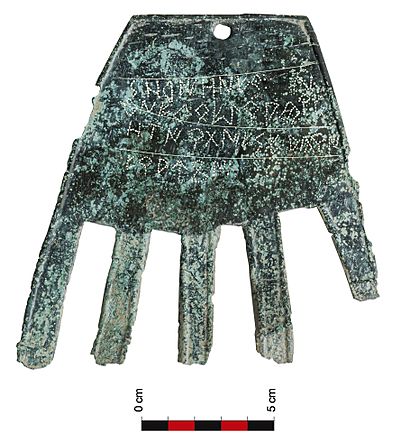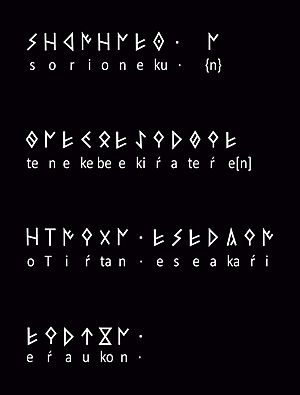Hand of Irulegi facts for kids
Quick facts for kids Hand of Irulegi |
|
|---|---|
 |
|
| Year | Between 80 and 72 BC |
| Medium | bronze |
| Subject | hand-shaped charm |
| Dimensions | 143.1 mm × 127.9 mm (5.63 in × 5.04 in) |
| Weight | 35.9 |
| Condition | Fair |
| Location | Aranguren |
The Hand of Irulegi is an amazing ancient object found in 2021. It's a bronze artifact shaped like a right hand. It was discovered during excavations at an old settlement called Irulegi. This site is near a medieval castle in Aranguren, south of Pamplona, in the Basque Country.
The hand has five lines of letters carved on its back. These letters likely form several words. What makes it so special is that it contains the oldest known writing in the Basque language. It's about 1,000 years older than any other Basque word found before!
Contents
What is the Hand of Irulegi?
The name "Hand of Irulegi" is a temporary name for this discovery. It was made around the 1st century BC. This was a time when a war called the Sertorian War was happening.
The people living in the Irulegi settlement chose sides in this war. As a result, their fortified town was attacked and burned. The roof of a house collapsed, which helped to protect and preserve the hand under the rubble.
Experts believe the hand might have hung on a door. It could have been used as a special charm to protect the house. Hand-shaped designs like this are very rare in this region.
What does the inscription say?
The writing on the hand uses an ancient script called Northeastern Iberian script. Here is what the letters look like:
sorioneku · {n}
tenekebeekiŕateŕe[n]
oTiŕtan · eseakaŕi
eŕaukon ·
The first word, sorioneku, is very exciting. It sounds a lot like the modern Basque word zorioneko. This word means "of good fortune" or "lucky."
The Hand of Irulegi is the oldest example of the Basque language ever found in writing. The ancient Iberian script was changed a bit to fit the sounds of the Basque language. One special letter on the hand looks like a "T" and has only been seen in areas where Basque people lived. Its exact sound is still a mystery.

How was it discovered?
The Hand of Irulegi was actually found in June 2021. This was during an excavation led by Mattin Aiestaran. However, the discovery was not announced to the public until November 14, 2022. The president of Navarre helped share the news.
After it was found, the hand was given to researchers to study. They quickly realized how incredibly important it was. On January 18, 2022, a restorer named Carmen Usua was cleaning the artifact. She noticed the writing on it. Experts who study ancient writings then confirmed that the hand had a natural downward position.
See also
 In Spanish: Mano de Irulegui para niños
In Spanish: Mano de Irulegui para niños
- Hamsa
- Iturissa
- Iruña-Veleia
- Aquitanian language
- Proto-Basque language
- History of the Basque language
- Paleohispanic scripts

